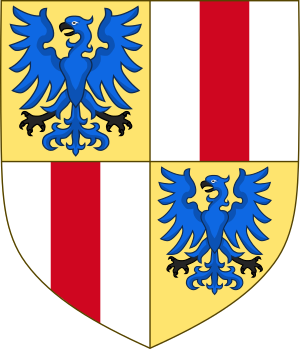George Carnegie, 6th Earl of Northesk facts for kids
Quick facts for kids
The Earl of Northesk
|
|
|---|---|

Arms of the 1st to 6th and 15th Earls of Northesk
|
|
| Born | 2 August 1716 Ethie Castle, Angus, Scotland |
| Died | 22 January 1792, age 76 Ethie Castle, Angus, Scotland |
| Allegiance | |
| Service/ |
|
| Years of service | c.1737-1792 |
| Rank | Admiral of the White |
| Commands held | HMS Bideford HMS Looe HMS Preston HMS Orford |
| Battles/wars | War of the Austrian Succession |
George Carnegie, 6th Earl of Northesk (born August 2, 1716 – died January 22, 1792) was a Scottish naval officer. He was also a peer, meaning he held a special title in the British nobility. George Carnegie served in the Royal Navy for many years. He fought in important conflicts like the War of the Austrian Succession and the First Carnatic War. During these wars, he took part in a naval battle in the East Indies on July 6, 1746. His time at sea ended early due to several illnesses. He never served on a ship again after becoming a rear-admiral in 1756. He passed away at age 75.
Contents
Early Life and Family Background
George Carnegie was born on August 2, 1716. He was the second son of David Carnegie, 4th Earl of Northesk. His mother was Margaret, the daughter of James Wemyss, Lord Burntisland. His family had a long history in Scotland.
George Carnegie began his career in the Royal Navy on March 15, 1737. He became a lieutenant, which is an officer rank. His first job was on HMS Dragon. This ship was part of the Mediterranean Fleet. In August 1738, while serving near Minorca, he became very ill. He recovered, but his health would be a challenge throughout his life.
Early Commands and Battles
In February 1740, Carnegie joined HMS Marlborough. Later, in May, he moved to HMS Edinburgh. His older brother passed away on June 23, 1741. This meant George became the Earl of Northesk. Soon after, on August 25, 1741, he was promoted to post captain. This was a significant step in his naval career.
He took command of HMS Bideford, a fast frigate. He patrolled the Western Approaches during the winter of 1741-42. In January 1742, he left Bideford. He then commanded HMS Looe starting in March. While in the Bay of Biscay, he chased an enemy privateer ship. He raided a town and captured four guns from its battery.
On July 7, he joined with HMS Deal Castle. They learned that enemy ships were hiding in Vigo. Their boats went into the harbor and captured four ships. They burned two of them while under heavy enemy fire. Carnegie returned to England in September 1742. He was then given command of HMS Preston. He served in the English Channel fleet, protecting convoys.
Service in the East Indies
In May 1744, Carnegie and Preston sailed to the East Indies Station. They were part of a squadron led by Commodore Barnett. On January 25, 1745, they found three French ships near Banca. These were heavily armed merchant ships. Carnegie's ship and Barnett's ship pretended to be Dutch vessels. They got close before the French realized they were enemies. After a two-hour fight, all three French ships were captured. Their valuable cargo was worth a lot of money.
Throughout 1745, Carnegie continued to protect British trade in the East Indies. He captured three more merchant ships. In 1746, he fought in a battle on July 6. However, he suffered from an illness that often kept him in bed. He returned to England in late 1747 to recover. He even traveled in Europe to improve his health.
Later Promotions and Retirement
In March 1755, he was given command of HMS Orford. This was as the Seven Years' War was starting. However, by May, he had to resign due to his ongoing health issues. He spent much of his later life in Bath for his health.
Carnegie was promoted to rear-admiral on June 4, 1756. He never took command of a ship at sea again. But because of his long service, he continued to be promoted. He became a vice-admiral on February 14, 1759. Finally, he reached the rank of admiral on October 18, 1770.
Death
Admiral George Carnegie passed away on January 22, 1792. He died at his home, Ethie Castle in Angus, Scotland. At the time of his death, he was one of the most senior officers in the Royal Navy. His titles then passed to his oldest son.
Family
George Carnegie married Lady Anne Leslie on April 30, 1748. They had six children:
- Lady Mary Anne Carnegie (died June 2, 1798)
- David Carnegie, Lord Rosehill (born April 5, 1749 – died February 19, 1788)
- Lady Elizabeth Carnegie (born 1751 – died August 19, 1793)
- Admiral William Carnegie, 7th Earl of Northesk (born April 10, 1756 – died May 28, 1831)
- Lieutenant Colonel George Carnegie (born August 21, 1773 – died 1839)
- Margaret Carnegie (born 1779 – died March 15, 1793)

